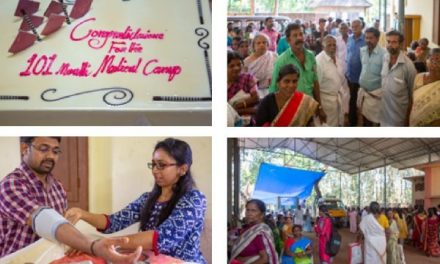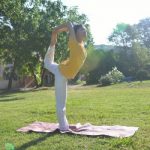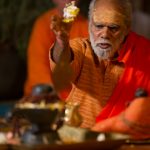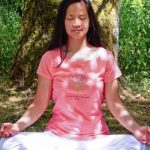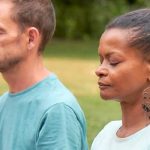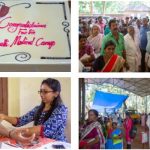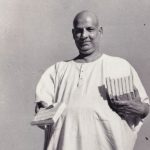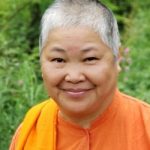 The Deeper Path of Yoga Teaching for Healing
The Deeper Path of Yoga Teaching for Healing
by Swami Sitaramananda
Yoga Life brings definite and visible benefits in the physical and mental health of individuals. It is multifaceted and deep. The yoga teacher who teaches Yoga Life needs to have in-depth knowledge of how to coach individuals, not only in the practice of asanas and pranayama, but also in ways of physical, mental and spiritual relaxation; in how to adopt a proper diet and lifestyle that increases prana; and in positive thinking and meditation.
The yoga teacher acts as a spiritual guide or counsellor in the four paths of yoga, guiding in the practice of selflessness, of selfless love, of self-analysis and self-enquiry.
 We recognise Sri Krishna, who counselled Arjuna on the battlefield, as the first yoga counsellor or spiritual guide. Yoga is taught on the battlefield of life. We struggle to find peace and happiness while dealing with life’s challenges, a process which causes wear and tear, and may create disease of body and mind.
We recognise Sri Krishna, who counselled Arjuna on the battlefield, as the first yoga counsellor or spiritual guide. Yoga is taught on the battlefield of life. We struggle to find peace and happiness while dealing with life’s challenges, a process which causes wear and tear, and may create disease of body and mind.
Health of body and mind and spiritual health are clearly interrelated. Spiritual insights bring about improvement in mental health and automatically induce the physical process of healing. Once disease has manifested in the physical body however, it is more of a challenge to reverse the process and effect healing.
Health and healing are a dynamic and ongoing process, not separate from but connected to the individual’s degree of self-knowledge and realisation. Self-knowledge, divine grace and faith play an important role in the journey towards well-being.
Swami Sivananda tells us that we are author of our own health and well-being. We often fail to realise that physical health depends on mental health, tending to view our physical ailments as something happening to us from the outside, and often suddenly. In fact, disease is frequently a wake-up call, a lesson about ourselves and an opportunity for self-transformation. Traumatic events or difficult karmic situations are often hidden and untold, leading to disease.
The spiritual element is ever-present in all cases but often down-played and misunderstood. We do not know that being spiritually healthy leads to mental and physical health. We do not know that the function of the mind and the body cells are regulated by the Atman, the Indweller. We do not know that healthy relationships and emotional balance are part of the well-being equation. The holistic, therapeutic approach of yoga addresses this complex issue of body-mind-spirit connection and interdependence.
The following case studies of yoga students illustrate this inter-relationship, the importance of spirit, and the benefits brought about by adopting an integrated yogic lifestyle. Each case shows a motivated individual and a spiritual teacher who coaches the individual in daily practice.
Case Study 1
Margaret was a 30-year-old yoga student who suffered from chronic fatigue syndrome and anorexia nervosa.
Margaret immersed herself in the yogic life, taking up residency at the Ashram to help restore equilibrium. After many weeks of experiencing a beneficial yogic community life and developing a positive relationship with the swami resident teacher, she revealed a history of severe sexual abuse within the family when she was young which had led to confusion, undermined a healthy approach to her body and robbed her of her desire to live.
Often times, she was unable to feed herself, unable to stand or walk normally, could only crawl to the bathroom, and became totally inactive. On good days, she was open and dynamic in such a way that no-one would have known of her problems and disabilities.
I observed that daily yoga practice over a sustained period helped to regulate and unblock her energy. Asana practice wakes tamas, calms rajas and nourishes sattva. For healing of the whole being—body, mind and spirit—energy must flow, and the mind must be calm so that the true spirit that is the intelligence governing the body and mind can be revealed. Her yoga practice gave her the strength to face the root cause of the problem and led her to confiding in me her history, an act which was the beginning of her healing journey.
She became devotional and actively maintained a loving relationship with her chosen form of God. She started to manifest love and trust again. Her daily participation in group satsangs, meditation and awareness practice brought her a better perspective on life. The episodes of excessive fatigue and anorexia lessened, restoring an improved quality of life. According to yoga philosophy, if the mind is not peaceful (sama), then it is not possible for the individual to connect to his/her spiritual being, resulting in distortions of reality and self-perception. Many are victims of abuse.
Yoga practice along with a pure lifestyle restores peace of mind and connection to the Self. This in turn balances the movement of healthy prana in the body and mind. I have often observed the impact of a safe environment and a loving, supportive spiritual life in healing.
Yoga Life in an Ashram or Centre often provides an alternative loving family. A supportive, loving and respectful relationship with a spiritual human being is an important element in the process of restoring self-love and respect. It reflects back the reality of who the individual really is as opposed to a distorted image created by the mind and its past experiences.
Case Study 2
Michael was a 45-year-old retired naval officer, suffering from leukaemia.
A supportive spiritual coach and a loving community, a practice of selflessness and self-worth, daily practice of yoga asanas and pranayama led to counselling sessions which revealed a previously untold story of abuse from authoritative spiritual figures in childhood. Michael started a daily practice of asanas and pranayama.
He worked on the practice of forgiveness, and actively cultivated detachment from the past. He worked on maintaining constant awareness of his thoughts in order to replace deeply-ingrained negativity with positive thoughts. Slowly his faith and trust were restored. Michael’s story confirms how re-connection to the spiritual helps to heal body, mind, spirit relationship. His disease went into remission and he was given a clean bill of health.
Often times when people experience psychic, mental, or emotional problems and tension in the body it is found that they breathe only through one nostril. In such cases, by practising alternate nostril breathing (anuloma viloma), and balancing the breath through both nostrils they find considerable improvement in their condition. The ability to relax increases through proper breathing— tension is released, prana is recharged, heralding a calm mind, and renewing the connection with the true Self that promotes healing. Pranayama is an essential element of hatha yoga for healing.
Case Study 3
Mark was a 40-year-old male, brought by his family to the Ashram in a partially catatonic state, needing constant care.
He was slowly introduced to gentle asana practice, daily chants and proper nutrition and and over time came back to life to tell a story of guilt and shame acquired in early life, including a background of drug abuse. After many years of regular yoga practice, he became a dynamic karma yogi, developed a down-to-earth approach to spiritual life, was able to successfully complete yoga teacher training and began teaching yoga.
How did this healing happen? During yoga practice, peace comes to the physical, mental and spiritual bodies. In deep relaxation, the practitioner rests in the causal body, and releases negative karmas carried in the subconscious. The practitioner connects with the true Self and develops a proper perspective on life, finding contentment irrespective of circumstance.
Case Study 4
Rose was a 35-year-old female yoga teacher who experienced a serious accident in which she broke both her hips and legs.
Counselling from her yoga teacher helped her to maintain positive thinking while in pain and during surgery. She was able to heal quickly. Gentle adaptive and restorative hatha yoga practice helped her regain mobility and a good range of motion after surgery. She regained her full range of functioning and is a grateful and active yoga teacher with a strong daily practice. She says that yoga saved her during and after the accident.
Yoga teachers should have a basic knowledge of how to adapt postures to specific conditions. Many come to yoga for restorative purposes and gentle, adapted yoga postures are required to assist them.
Case Study 5
Lanny was a 24-year-old female yoga student, suffering from severe acne, her face disfigured with pimples. She had poor self-esteem and suffered from depression.
She sought yogic counselling and received advice on positive thinking and how to foster detachment from a demanding relationship with her mother. She was advised to adopt a regular hatha yoga practice, changed her diet and modified her lifestyle. She received herbal therapies prescribed by an ayurvedic doctor. Her condition improved and she regained self-confidence and now leads a creative and positive life.
The emotions and the mind affect the health of the body. A yoga teacher should be able to give simple advice on how to calm the emotions, how to deal with relationships and how to use the wisdom of ayurveda for simple ailments as well as for detoxification.
Health and Absence of Health is Threefold
A state of physical health exists when all organs function optimally under the intelligent control of the mind. Mental health prevails when the mind is calm and able to focus. Emotional health is achieved when there is an absence of negativity towards others, when there is universal, unconditional love. Spiritual health is when we are connected consciously to our spirit. Maintenance of health consists of the yoga practices that remove the obstacles to good health.
Connection to spirit manifests as self-love, self-care, creativity, calmness, equanimity, presence, connection with others, and balance in thought and action. Lack of connection to spirit manifests as restlessness, darkness, mental fluctuation, living in the past, fear, anger, blaming and emotional dramas. In all situations of pain and suffering that which is missing is connection to spirit, and that which is effective in alleviating suffering is connection to spirit. If we can bring about that connection, mental and physical symptoms are alleviated, and the body-mind complex heals itself.
Yoga Practices and Connection to the Self
Mental or physical disease is a symptom of lack of connection to the spiritual aspect of our being. Connection becomes blocked, and there is a tendency to mis-identify or distort the idea of self. Conventional healing methods are often ineffective in these cases. A classical yoga practice brings the ailing person back to a natural undistorted connected state. Yoga has the capacity to counteract the forces within the individual that tend to lead him or her to extremes.
These negative karmic patterns are frequently reinforced by upbringing and relationships, and it can take considerable time and constant awareness to re-establish healthy patterns. The presence of a spiritual guide or yoga teacher is often necessary during this time. Sometimes, after reaching the lowest point, the individual may catch a glimpse of reality but cannot sustain their efforts. Regular yoga asana practice and the practice of self-restraint regulate the emotional upheavals and bring contentment and peace.
Yoga requires concentration and counteracts the tendency of the mind to wander, to escape into fantasy, to reinforce mistaken ideas. Having attained health the individual needs to sustain this by regular sadhana, reinforced in a community situation, or satsang. It is difficult for an individual to maintain regular practice on his or her own due to deeply ingrained negative habits. The home environment often reflects the disease. Spiritual community or satsang provides a healing environment.
A yoga teacher who cares for the students becomes a spiritual guide and health counsellor in a larger sense. The yoga teacher is to have an understanding of the deeper aspects of yoga techniques, be able to adapt postures and classes to specific individual conditions, and to be able to help an individual through knowledge of yoga psychology and philosophy. The teacher should have an understanding of the basics of ayurveda; as well as of jyotish to help determine the karmic tendency.
Yogic methods are always the same: understanding that the connection to spirit is the main key to healing. This connection will be attained by a return to conscious breathing, practice of asanas, deep relaxation, proper nutrition, positive thinking and meditation and by attending yoga retreats, by moving out of isolation, and by cultivation of devotion, trust, faith and detachment.
Aids to Healing
Daily asana and pranayama
An understanding and empathetic teacher
Detachment
Community life
Self-study
Eradication of bad habits or addictions
Healthy diet
Seclusion and satsang, yoga retreats
Emotional sublimation, kirtan
Karma yoga
Concentration
Forgiveness, acceptance
Regularity, moderation, daily routine
Moderation of senses
Positive self-image
Self-expression
Listening
Relaxation, awareness
Bodywork, massage
Swami Sitaramananda, Acharya – Spiritual Teacher and Lineage holder, California and most of South Asia e-mail: [email protected].



